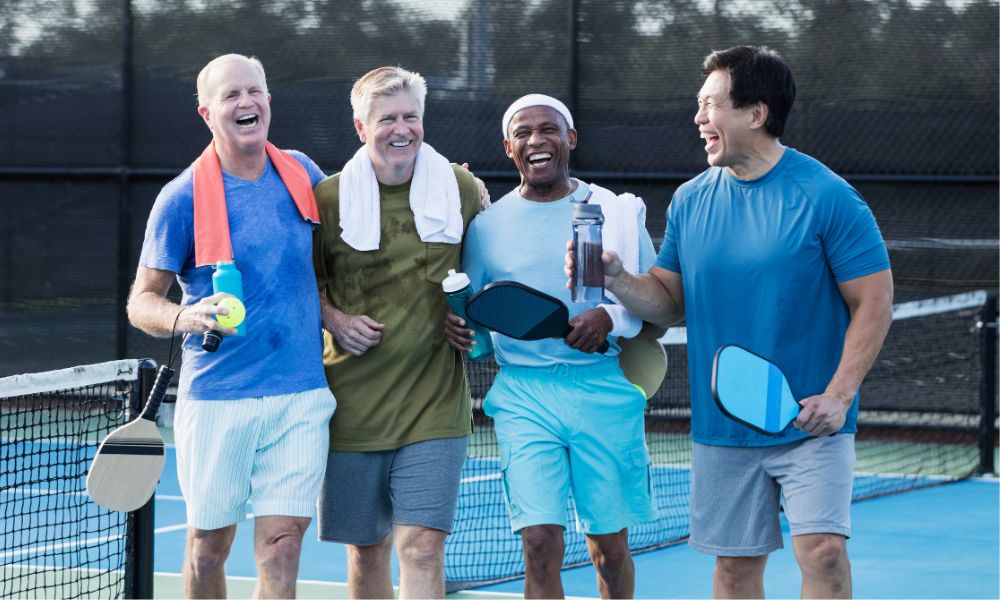The sun is shining, the grass is greener, and the air feels a little warmer. It’s finally spring! For many athletes, that means getting back to their favorite sports, whether it’s hitting the baseball field, joining a soccer league, or training for a big race. But before you lace up your cleats or grab your gear, it’s important to take steps to protect your body.
Spring is a prime time for sports injuries, especially after a long winter break. Fortunately, with a little preparation and smart training, you can stay in the game and avoid being sidelined.
Dr. David Rodriguez, a sports medicine specialist at St. Joseph’s Health explains, “Spring sports often bring a sudden increase in physical activity after months of less movement, which can lead to muscle strains, ligament tears, and overuse injuries. The key is to gradually build strength, improve flexibility, and listen to your body.”
Here’s what you need to know to prevent common spring sports injuries and keep yourself performing at your best.
Warm Up and Cool Down Like a Pro
Skipping a warm-up is one of the biggest mistakes athletes make. Warming up gets your blood flowing, increases muscle temperature, and preps your body for more intense movement.
“Start with 5 to 10 minutes of light cardio like jogging or jumping jacks, followed by dynamic stretches that mimic the movements you’ll be doing in your sport,” encourages Dr. Rodriguez. “Dynamic stretches, such as leg swings or arm circles, help improve range of motion and reduce the risk of injury.”
Don’t forget the cool-down. After practice or a game, spend a few minutes stretching and doing light movements to gradually lower your heart rate. This helps prevent stiffness and promotes faster recovery.
Ease Back Into Activity
If you’ve been less active over the winter, resist the urge to go full speed ahead as soon as spring hits. Sudden bursts of intense activity can strain muscles, connective tissue, and joints that aren’t ready for the load.
“Take your time to rebuild endurance and strength,” advises Dr. Rodriguez. “Increase activity levels gradually over a few weeks. This approach gives your muscles and ligaments time to adapt, reducing the risk of overuse injuries.”
A good rule of thumb is to increase intensity or duration by no more than 10% each week.
Strengthen Key Muscle Groups
Strong muscles provide stability and support to your joints, which lowers the risk of injury. Focusing on core strength, along with the muscles used in your sport, helps maintain balance and control during quick movements.
“Core stability is essential for preventing injuries, especially in sports that require twisting, jumping, or sudden directional changes,” stresses Dr. Rodriguez. “Incorporate exercises like planks, squats, and lunges to strengthen your core, legs, and hips.”
If you’re playing a sport that involves repetitive movements (like throwing in baseball or swinging a tennis or pickleball racket), don’t forget to strengthen the opposing muscle groups to maintain balance.
Pay Attention to Proper Technique
Good form is critical in preventing injuries. Whether it’s your running posture, throwing mechanics, or tackling technique, poor movement patterns can put extra stress on your body.
“Coaches and trainers can be a great resource for improving technique,” notes Dr. Rodriguez. “If something feels off or painful, it’s worth having your form evaluated to avoid more serious issues down the road.”
Stay Hydrated and Fuel Your Body
Hydration and nutrition play a bigger role in injury prevention than most athletes realize. Dehydrated muscles are more prone to cramping and fatigue, which can lead to poor form and increased injury risk.
“Drink plenty of water before, during, and after activity, especially as temperatures rise in the spring,” Dr. Rodriguez suggests. “Also, make sure you’re eating nutrient-rich foods that support muscle recovery and overall performance.”
Foods high in protein, healthy fats, and complex carbs give your body the fuel it needs to perform and recover effectively.
Listen to Your Body and Rest When Needed
Pushing through pain is never a good idea. Mild discomfort can quickly escalate into a serious injury if ignored. “Pay attention to early warning signs like soreness that doesn’t go away, swelling, or decreased range of motion,” cautions Dr. Rodriguez. “Taking a break and allowing your body to heal is always better than being forced to sit out for weeks due to a preventable injury.”
If something doesn’t feel right, take a day or two off to rest and ice the affected area. If the pain persists, it’s best to seek medical advice.
Wear the Right Gear for Your Sport
Protective gear is essential for reducing the risk of injury. Make sure your equipment fits properly and is in good condition. “Helmets, pads, braces, and supportive footwear play a big role in preventing sports-related injuries,” recommends Dr. Rodriguez. “Don’t overlook the importance of wearing gear that’s appropriate for your activity.”
For runners and athletes who spend a lot of time on their feet, replacing worn-out shoes can help prevent foot, ankle, and knee pain.
When to Seek Medical Help
Despite your best efforts, injuries can still happen. If you experience persistent pain, swelling, or limited mobility, it’s important to see a specialist.
“Delaying treatment can turn a minor issue into a bigger problem,” warns Dr. Rodriguez. “At St. Joseph’s Health, we offer expert orthopedic care to help athletes get back to doing what they love as quickly and safely as possible.”
Stay Safe and Enjoy the Season
Spring sports are a great way to stay active, have fun, and build lifelong skills. By taking steps to protect your body, you can reduce the risk of injury and enjoy a safe, successful spring sports season. Remember, staying proactive with warm-ups, proper technique, and listening to your body is your best defense against sports-related injuries.
If you have concerns about an injury or need guidance on safe sports participation, the expert team at St. Joseph’s Health is here to help. Schedule an appointment with one of our orthopedic specialists today!







